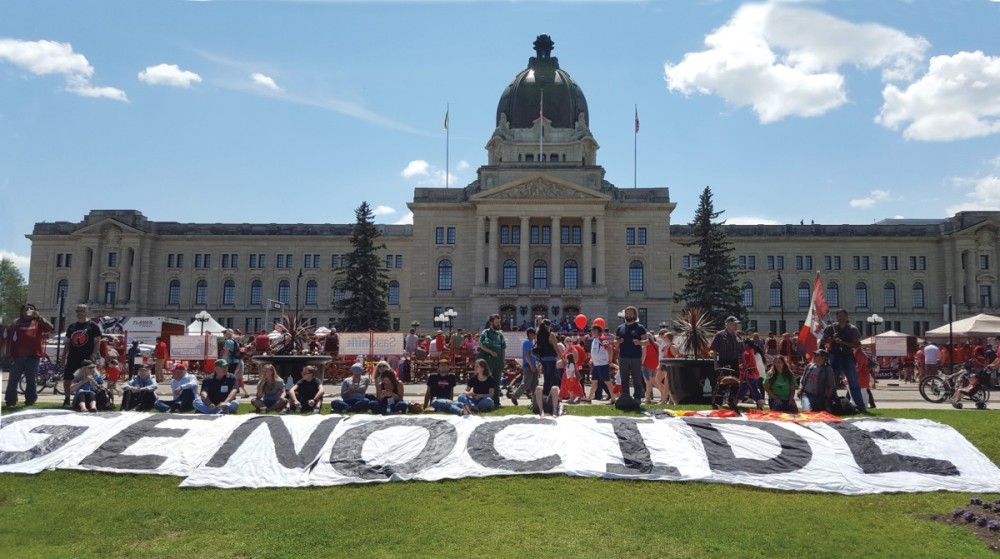Reconciliation is not a pardon but a naming — an acknowledgment and validation of past and current injustices. The most practical metaphor for reconciliation is accounting. Both sides must balance. That begins with a reckoning, a calculation of not only the fiscal (or physical), but the mental, social, and spiritual balances as well — those of the people and the state.
This is my reconciliation journey.
I have been a labour activist, educator, and advocate for decades. Born in Louisiana of mixed-blood ancestry, I grew up during the height of the Civil Rights Movement, which helped instill my instinctive response to challenge injustice.
I enjoy a great deal of privilege. I have a union job, shelter, transportation, food. I don’t have to worry about my basic needs. I can also leverage my privilege because I am white-coded. One of those privileges illustrated throughout this story is an ability to access resources, both my own and, gratefully, those of the organizations of which I am a member.
I’ve organized the Camps I refer to in this article into two groups, based on the extent of my participation in them. The first three Camps were those in which I was directly involved. The second set are Camps in other cities where my role was visitor, supporter, learner, and envoy from the Regina Camps. The Camps can be classified on a spectrum, but the easiest way is based on their specific characteristics such as message, size, support, duration, time of the year, and how strongly opposed the state was to their efforts.
The Regina Camps
Colonialism No More
OccupyINAC actions in April of 2016 were an outcry in response to the suicide crisis in Attawapiskat, a remote, neglected community in Northern Ontario. Indigenous and Northern Affairs Canada (INAC) offices (now Indigenous Services) were occupied in Winnipeg, Toronto, and Vancouver. In Regina, in contrast, a Camp was struck outside the INAC offices metres from Albert Street, the city’s busiest thoroughfare. Colonialism No More (CNM) was the name for the coalition of grassroots Indigenous people, social justice organizations, students, and labour activists who formed the Camp, or as one of the Campers, Michelle Stewart, quipped, “A rich smoothie of social justice.”
Support for the Camp came from many and in as many ways. The Canadian Mental Health Association (Regina) provided an alternate meeting place, shelter, and kitchen facilities. The Canadian Union of Public Employees provided a large tent. About 50 delegates from Unifor Prairie Regional Council delivered a generator. Individuals stopped by regularly with donations of food, coffee, money, and other supplies to sustain the Camp. Visitors included tourists, the curious, the benevolent, and even sometimes the ill-intentioned. All were welcomed.
Bob Smoker, CNM’s Elder, provided direction and a soothing presence. His term for the Camp was Standing Strong Together, a prophetic name considering the solidarity our group has shown in actions challenging injustice since.
Some of our demands were met. The Town Hall with INAC was a genuine dialogue. Most issues won’t be solved overnight. Su Deranger, one of the Camp founders, said it best, “We need poverty to end. We need suicides to end. We need clean water. We need adequate housing. We need, finally, for there to be justice. And we need to do this together.”
Camp Justice for Our Stolen Children
Two verdicts drove actions across the nation when settlers were exonerated in the deaths of two Indigenous youth, Colten Boushie and Tina Fontaine. These verdicts demonstrated bias in the justice system and how it functions to protect colonialism. Systemic racism in child protection and the criminal justice system indicates the government’s intention is and always has been to destroy Indigenous culture.
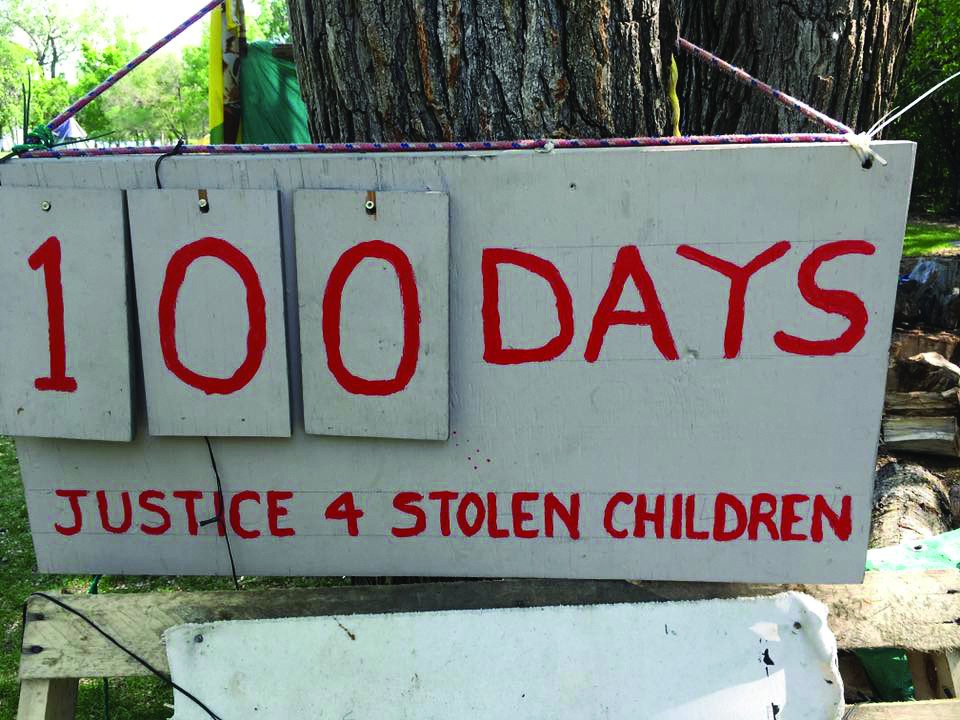
PHOTOGRAPH: COURTESY DON WREN
Camp Justice for Our Stolen Children (CJFOSC) began in 2018 in the deep winter of the Prairies. One central tipi and a few makeshift shelters began a community which eventually grew to 15 tipis. The Camp was situated diagonally from the Legislative Building in Regina directly across the street on the West Lawn of the Legislative Grounds.
Our aim was to change a system serving everyone but us.
Richelle Dubois’ son, Haven, 14 years old, died under suspicious circumstances in 2015. The authorities said otherwise and refused to open an inquiry into the investigation. Richelle and Prescott Demas, one of the central figures from CNM, were among the core Campers who continuously occupied the Camp.
Campers sought meaningful dialogue with their representatives but were instead met with state violence. Camp was located on the site planned for the Canada Day Beer Garden. Days prior to that, six of the campers were arrested and a sacred fire which had been burning in the central tipi was extinguished in an act of blatant bigotry, a state-sanctioned hate crime. Unknown to the enforcers, coals from the fire were taken off-site and after the unwelcome thugs were gone, the sacred fire was re-lit. Instead of a beer garden, Canada Day was celebrated with the Trespassers’ Powwow, a beautiful day of drums, dancers, horses, and more tipis.
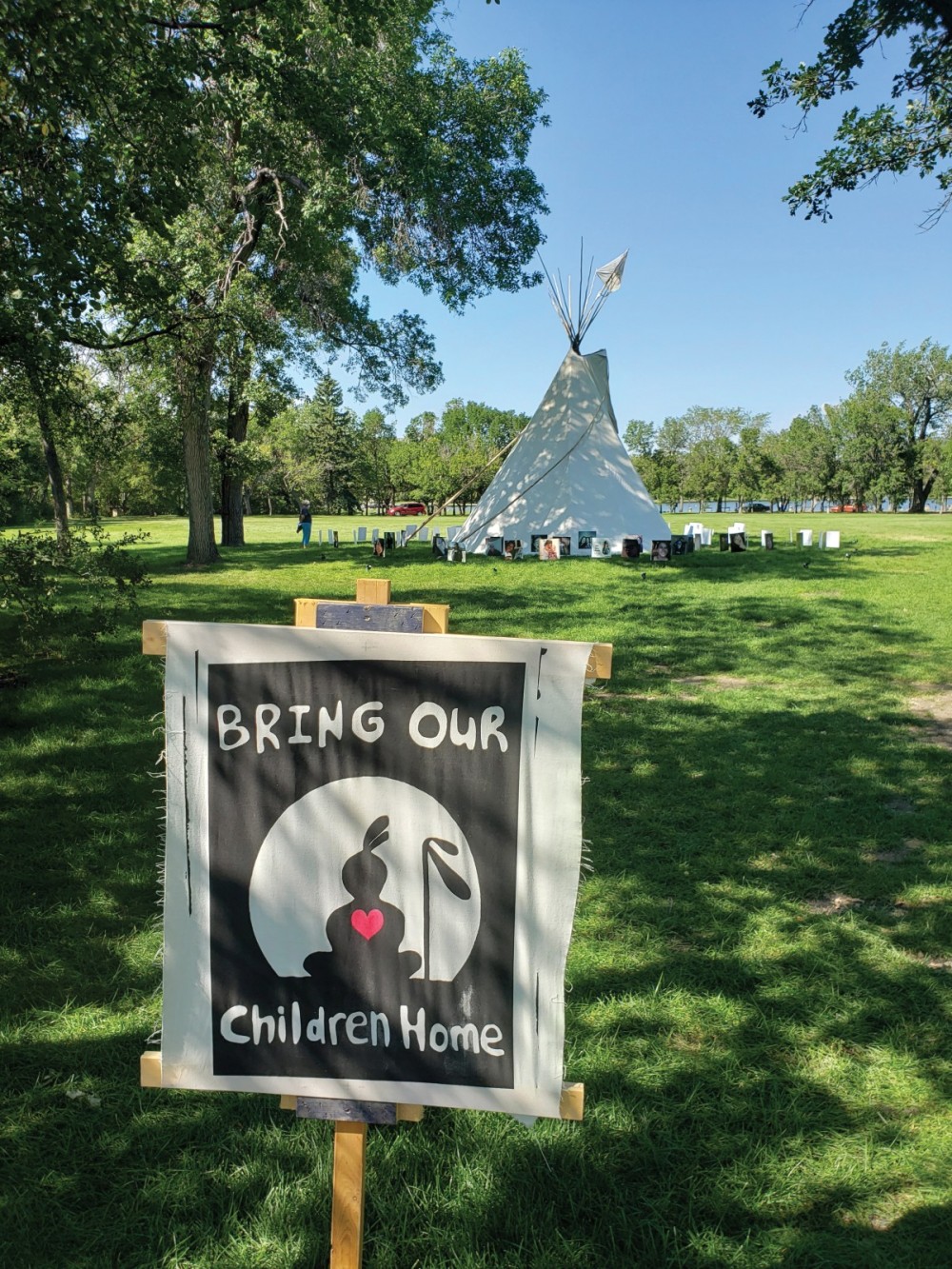
Camp Justice for Our Stolen Children. Regina, 2018. PHOTOGRAPH: COURTESY CAMP JUSTICE FOR OUR STOLEN CHILDREN.
On September 7, a Saskatchewan judge, Ysanne Wilkinson, ordered the dismantling of the Camp. While legal repercussions had the effect of temporarily dampening the ability of the core Campers to engage in direct action, some moved into advisory roles in later actions. Skills honed during the Camps continue to be useful. The team formed during CNM and refined during CJFOSC continues to support efforts to assert Indigenous sovereignty.
There is a documentary about the Camp called Justice for Our Stolen Children (2019). It was directed by Kristen Anderson-Sauvé and Robyn Pitawanakwat, spokesperson for the Camp.
Walking With Our Angels
Walking With Our Angels Camp (WWOA) was a tribute to those lost to suicide in northern Saskatchewan and a bold statement to the government, declaring their response to this crisis unacceptable.
Tristen Durocher, a young Métis fiddler, and Christopher Merasty set up a tipi on the West Lawn of the Legislative Grounds in Regina. Tristen began a ceremonial fast while a sacred fire was lit.
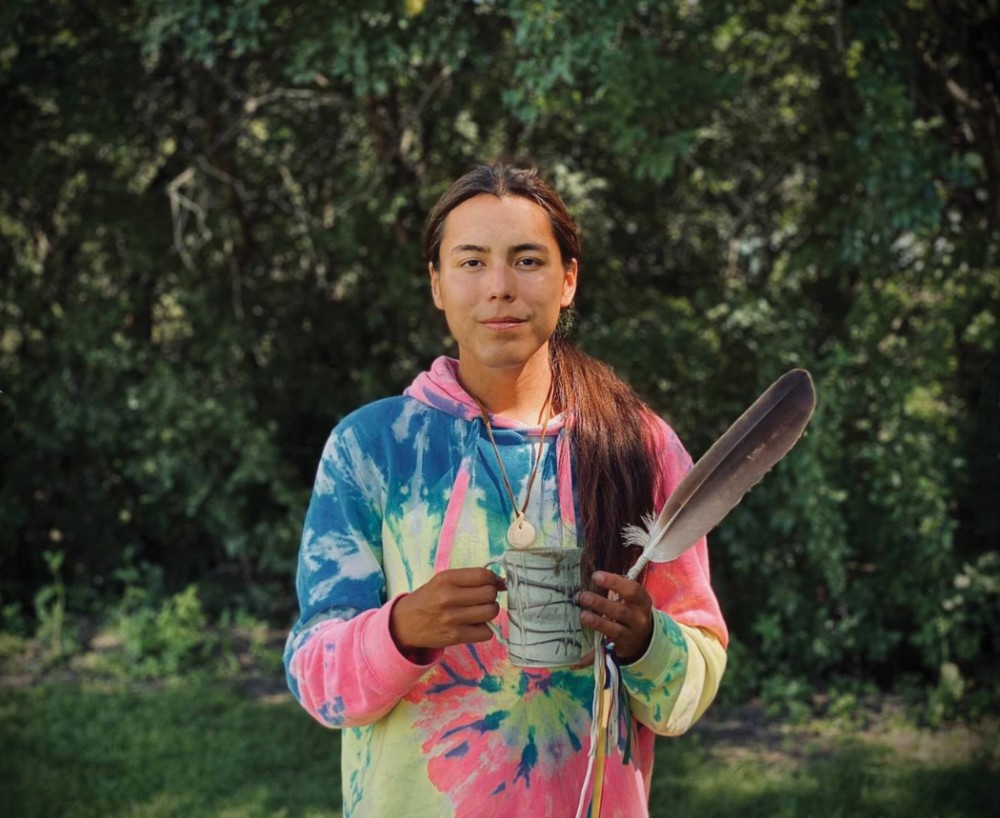
Tristen Durocher. In Don Wren’s words, “a friend with a vision.” PHOTOGRAPH: COURTESY DON WREN.
The ceremony ended after 44 days, a number symbolizing the 44 MLAs who voted against an NDP-sponsored suicide prevention bill.
The sacred fire and ceremonial fast were spiritual acts and primary factors in the decision to overturn the Provincial Capital Commission’s (PCC) eviction notice. Judge Graeme Mitchell’s ruling recognized Tristen’s constitutionally protected rights and ordered the PCC to leave him alone.
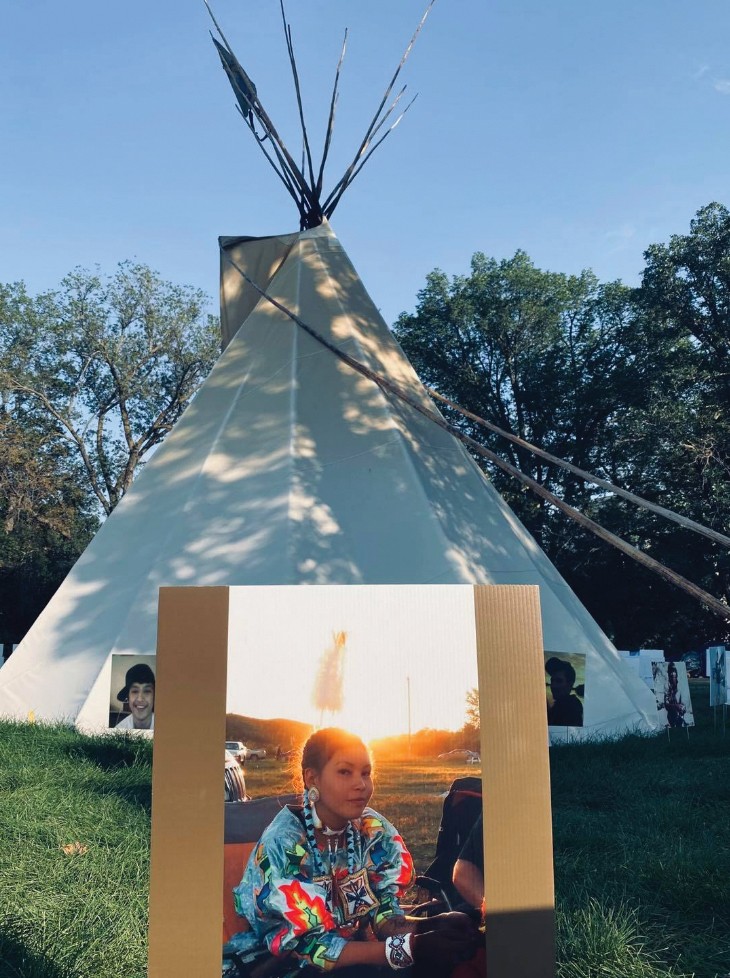
Angels surround the tipi of the Walking With Our Angels Camp. PHOTOGRAPH: COURTESY DON WREN.
Mitchell also instructed them to rewrite their bylaws to respect constitutionally protected forms of expression.
Neoliberal governments can’t be expected to care about people. Worse yet, we must expect their active opposition to our demonstration against their indifference. Walking With Our Angels Camp was a healing place. The placards with the faces of our Angels surrounding the tipi reminded us of those lost, but also that hope is possible. Waiting for government action is futile.
The Other Camps
Rooster Town Blockade
The Rooster Town Blockade at Parker Wetlands in Winnipeg was established in July of 2017 to prevent development in the environmentally sensitive area. The Wetlands were home to many threatened species and the site of the former Métis road allowance community of Rooster Town. In the early 20th century, the community’s homes sat just north of the Wetlands.
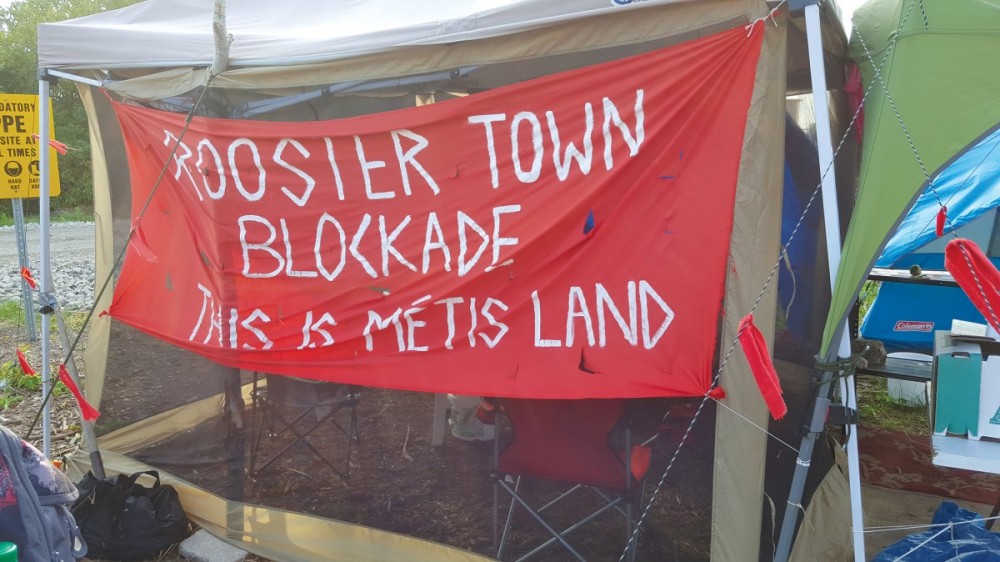
PHOTOGRAPH: COURTESY DON WREN
My first unaccompanied visit was to introduce myself and ask about Camp needs. I had never seen tree-shredding machines like those being used to clear-cut the area, but they were now idle due to the actions of the Blockade.
I returned a couple of days later with some colleagues in town for a convention. After pleasantries with the surveillance crew at the gates, we visited with Jenna Vandal, the principal organizer of the Blockade. An Elder and former resident of Rooster Town, Frank Sais, showed us the location of his childhood home and where he used to snare rabbits. He said when the area was developed and a large shopping mall and public high school built in the 1960s, inhabitants of Rooster Town either accepted the city’s offer to relocate or were forcibly removed. Development destroyed a vibrant Métis community on the outskirts of the city, one of the few places Métis were allowed to live.
During that second visit to the Camp, we saw a doe and her fawn separated by the fence the developers had put up.
In September 2017, the Manitoba Court of Appeal granted an injunction against the Rooster Town Land Defenders and the Blockade was dismantled. Soon after, the Parker Wetlands were destroyed.
Ground Zero INAC Toronto
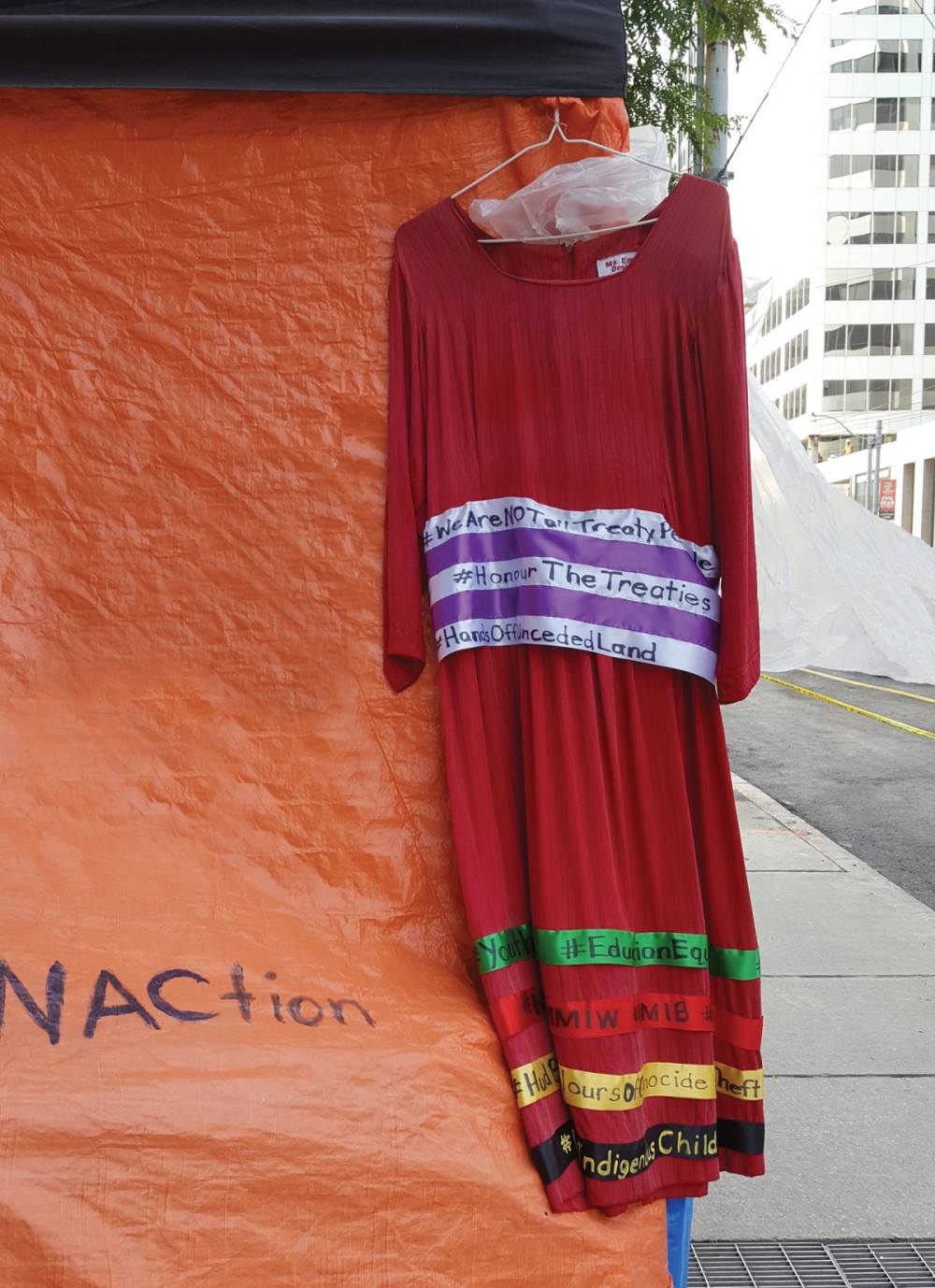
The red dress on the southwest side of the Ground Zero INAC Toronto Camp. PHOTOGRAPH: COURTESY DON WREN.
Ground Zero INAC Toronto was a follow-up to the OccupyINAC actions at the office of Indigenous and Northern Affairs Canada in April of 2016.
In July 2017, activists started the Camp, which lasted for more than five months. Carrie Lester (of blessed memory), Sigrid Kneve and Sue-Lynn Manone occupied a section of sidewalk with a makeshift shelter and messages drawing attention to the ongoing crisis and urging change. Not One More Indigenous Child (#NOMIC) was the message of the largest poster.
There is a documentary on the Camp entitled Day 61 at: archive.org/details/Day61_201710.
Soaring Eagle’s Camp
Soaring Eagle's T’karonto was one of three Soaring Eagle Camps. The others were short-lived Camps in Winnipeg and Calgary which evolved into longer Camps. The T’karonto youth-led Camp was founded by Koryn John, a young Ojibway activist, on March 4, 2018, in response to the acquittal of a settler in the murder of Colten Boushie, and immediately after that, the acquittal of another settler in the death of Tina Fontaine.
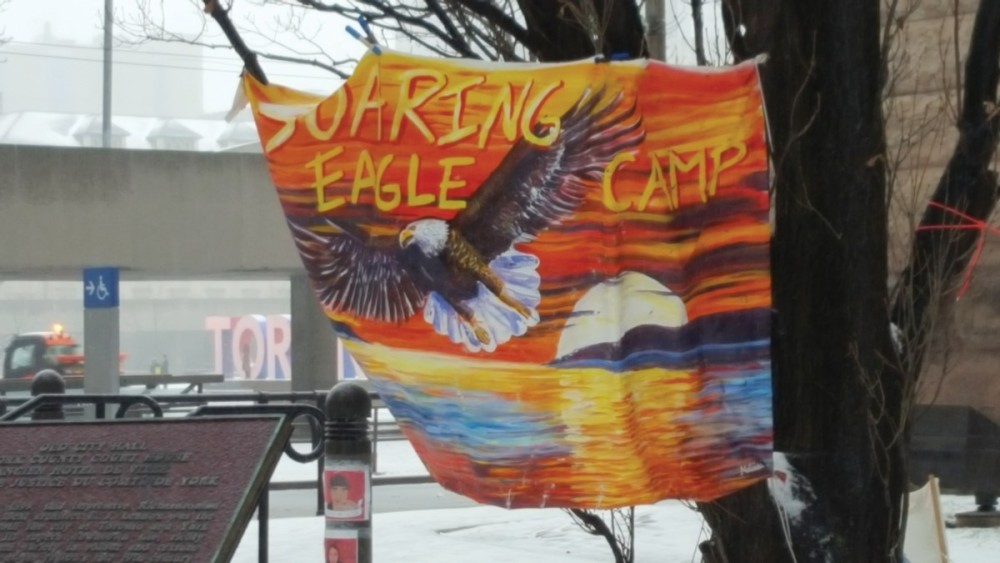
A banner for one of the Soaring Eagle’s Camps. PHOTOGRAPH: COURTESY DON WREN.
The Campers endured a great deal, including brutal winter weather. When I visited them in March, one Camper and I spent much of the time keeping ice off the structures during a huge ice storm. And Old City Hall, beside where the Camp was located, sheds ice. It was coming down in droves.
The Camp closed May 25, 2018, with a social media message of solidarity: “Warrior cry to the other camps that are and were up. We are with you Camp Mohkinstsis in Calgary, Camp No Justice Just Us in Winnipeg, Camp Justice for Our Stolen Children in Regina.”
What I Learned
- Our existence demands the state’s violence primarily because of its insecure and tenuous right to lands obtained by deception. This country’s foundation is questionable. The Canadian state’s economic dependency on Indigenous lands and resources conflicts directly with Indigenous concepts of land, place, and space.
- Canada’s insecurity is apparent and directed its reluctant recognition of the right to Indigenous self-determination from the United Nations Declaration on the Rights of Indigenous Peoples (echoed in the Truth and Reconciliation Commission’s Call to Action #43). Canada’s list of human rights abuses is vast but even more horrific considering Canada decides the rights they “allow” Indigenous people.
- The Camps were a form of spiritual expression. The sacred fire gave the Camps ceremonial significance. Judge Mitchell’s ruling recognized the spiritual nature of the WWOA Camp whereas Wilkinson’s ruling against CJFOSC Camp demonstrates the fickle, inflexible, and often narrow-minded nature of Canadian jurisprudence. The Camps were communities enabling acts of self-expression and providing spiritual refuge.
- Canada has created and commodified an internal, dependent colony of Indigenous People, consigned to the edges of society where we have little to no influence in affecting decisions about us. Our dependency on the state is economic, political and cultural and that dependency is used to confine, co-opt, or erase.
- No community is perfect. People come to this work with different ideas about how best to accomplish widely varying goals. The infinite number of variables involved in a group effort inevitably leads to conflict. Each contributor brought their best whether their skills were in fundraising, art, logistics, or messaging (most importantly, social media messaging). We made decisions consensually, worked through (most of our) conflict, and became a family.
What’s Next?
Solidarity actions like these demonstrate unions can be instrumental in making change in society. We have a responsibility to use our collective power to challenge injustice.
When resistance has been criminalized to the point where erecting a tipi is an act of protest, Canada must examine its motives. “The people are ready, the government isn’t,” says Prescott Demas.
Last winter solstice, Honouring Our Matriarchs was held on the West Lawn of the Regina Legislative Grounds, the site of two of the Camps I’ve written about. There were 13 tipis with Prescott Demas’ tipi standing in the centre, just as it had during the time of the Justice for our Stolen Children Camp. Prescott’s tipi held the fire from which all the other fires of the Camp were lit. In each tipi, a Women’s Pipe Carrier offered teachings. Men set up the tipis, chopped the wood, and kept the fires while the women participated in ceremony. This is decolonization in process, aka reconciliation in action. We were challenging patriarchy, the system which outlawed our ceremonies, with ceremony honouring the spirits and beginning the year on the land.
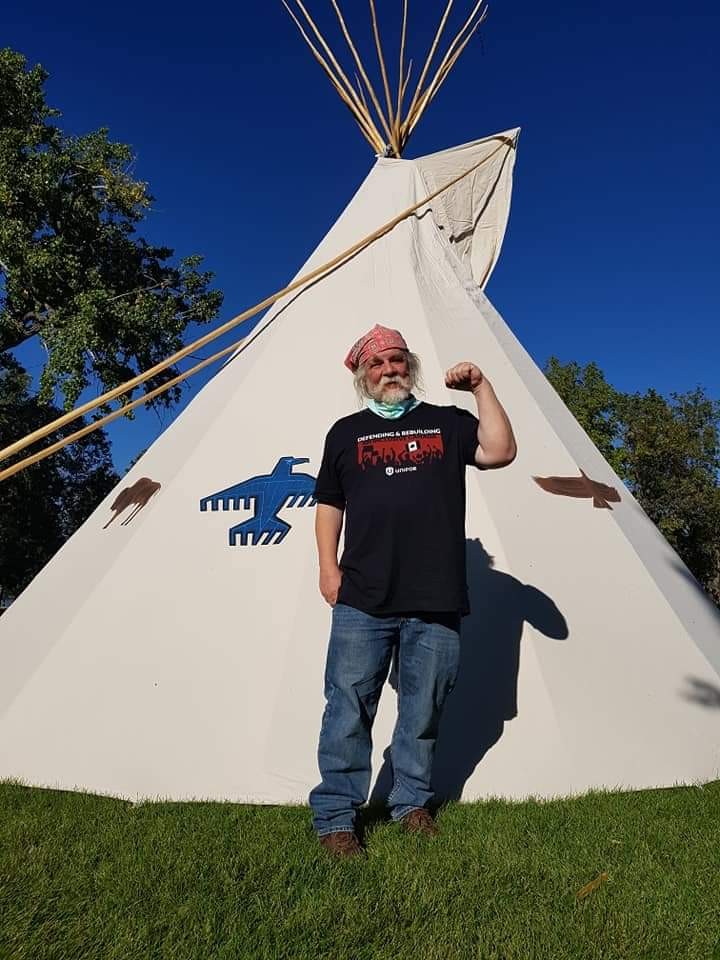
Don Wren in front of a tipi set up by the Unifor Aboriginal and Workers of Colour committee on World Suicide Prevention Day, during Camp Walking With Our Angels. PHOTOGRAPH: COURTESY DON WREN
These expressions of Indigenous sovereignty challenge not only the participants, but the city, the province, and the country. This new way of protesting builds community, offers much-needed help for a severely underserved population, and holds promise as a new grassroots form of resistance.
This has been a life-changing experience for me, and for many others. Camp Justice for Our Stolen Children has visitor logs, signed by hundreds of people from around the world. What began as a visit over a cup of coffee became part of a process which changed the way government thinks about protest and the way we think about it as well. Each Camp had its own impact. Government doesn’t listen, but they can’t ignore us when we show up on “their” lawn.
Four is a significant number in some cultures. Each of the Regina Camps were two years apart. The third and last one was two years ago. And this year is moving quickly.
Don Wren works as a Human Rights Advocate for a local in Regina. He is a graduate of the Saskatchewan Indian Federated College, University of Alaska, and the Labour College of Canada. He is also an alumnus of the Governor General’s Canadian Leadership Conference.


